Articles
- Page Path
- HOME > Korean J Community Nutr > Volume 22(1); 2017 > Article
-
Research Article
- Lifestyle, Dietary Behavior and Snack Preference of Upper-grade Elementary School Students in Cheongju according to the Usage Time of Smartphones
-
Hayeon Kim, Munkyong Pae

-
Korean Journal of Community Nutrition 2017;22(1):40-52.
DOI: https://doi.org/10.5720/kjcn.2017.22.1.40
Published online: February 28, 2017
Department of Food and Nutrition, Chungbuk National University, Cheongju, Korea.
- Corresponding author: Munkyong Pae. Department of Food and Nutrition, Chungbuk National University, 1 Chungdae-ro, Seowon-gu, Cheongju, 28644, Korea. Tel: (043) 261-2745, Fax: (043) 267-2742, mpae@chungbuk.ac.kr
Copyright © 2017 The Korean Society of Community Nutrition
This is an Open-Access article distributed under the terms of the Creative Commons Attribution Non-Commercial License (http://creativecommons.org/licenses/by-nc/3.0/) which permits unrestricted non-commercial use, distribution, and reproduction in any medium, provided the original work is properly cited.
- 1,327 Views
- 6 Download
- 13 Crossref
Figure & Data
REFERENCES
Citations

- Evaluation of the association between nomophobia, mindful eating, and nutritional status
Aliye Kuyumcu, Müberra Yıldız, Kadriye Toprak
Turkish Journal of Clinics and Laboratory.2025; 16(2): 349. CrossRef - The impact of maladaptive perfectionism on college students' bedtime procrastination: The chain mediating effects of nomophobia and physical exercise
Yong Jiang, Chuanyang Jiang
Acta Psychologica.2025; 260: 105504. CrossRef - The relationship between smartphone usage and eating behavior for elementary school students in Gangneung, South Korea: cross-sectional study
Minji Kim, Meera Jang
Korean Journal of Community Nutrition.2024; 29(4): 278. CrossRef - Screen time, mealtime media use, and dietary behaviors in Korean preschoolers: a cross-sectional study
Young-Hee Han, Saerom Shin, Eun Yeol Woo, Hye-Kyung Park, Taisun Hyun
Korean Journal of Community Nutrition.2023; 28(3): 206. CrossRef - Comparing the Mediating Effect of Adolescent Lifestyle Profiles on the Relationship between Smartphone Addiction and Health-related Quality of Life Among Male and Female Senior High School Students in the Philippines
Danilo B. Buctot, Nami Kim, Sun Hee Kim
International Journal of Mental Health and Addiction.2023; 21(1): 511. CrossRef - The Effects of Smartphone and Internet Gaming Addiction on Eating Attitudes Among University Students
Bahar Yeşil Örnek, İbrahim Gündoğmuş
Psychiatry Investigation.2022; 19(1): 1. CrossRef - The role of nomophobia and smartphone addiction in the lifestyle profiles of junior and senior high school students in the Philippines
Danilo B. Buctot, Nami Kim, Sun Hee Kim
Social Sciences & Humanities Open.2020; 2(1): 100035. CrossRef - Relationship between the Intake of Children's Favorite Foods and Policy based on Special Act on Safety Control of Children's Dietary Life
Taejung Woo, Jihye Yoo, Kyung-Hea Lee
Korean Journal of Community Nutrition.2019; 24(2): 106. CrossRef - Health Behavior Factors Associated with Sugar-sweetened Beverage Intake among Adolescents
Hyae Min Gu, Jong Park, So Yeon Ryu
Korean Journal of Community Nutrition.2018; 23(3): 193. CrossRef - A Study on Weight Control Behaviour, Eating Habits and Health-related Life Habits According to Obesity Degree of University Students in Jeonbuk
Hye-Soon Chang
Korean Journal of Human Ecology.2016; 25(1): 73. CrossRef - Weight loss effects of Bariatric Surgery after nutrition education in extremely obese patients*
Eun-Ha Jeong, Hong-Chan Lee, Jung-Eun Yim
Journal of Nutrition and Health.2015; 48(1): 30. CrossRef - A Study of Nutrient Intakes, Blood Lipids and Bone Mineral Density according to Obesity Degree by Percentage of Body Fat and Age between Male and Female Teacher in Jeonbuk Province, Korea
Hye-Soon Chang
Korean Journal of Community Nutrition.2012; 17(1): 49. CrossRef - A Study of Glycemic Index, Glycemic Load and Food Sources according to Body Mass Index in Female College Students
Jee-Young Yeon, Eun-Young Kim
Korean Journal of Community Nutrition.2012; 17(4): 429. CrossRef
General characteristics of the study subjects by smartphone usage time
1) N (%)
2) Obesity index = (body weight – standard body weight) / standard body weight × 100
3) Non-addicted (S-scale score ≤ 41 pt), Addicted (S-scale score ≥ 42 pt)
*: p < 0.05, **: p < 0.01, ***: p < 0.001
Snacking behaviors of the study subjects by smartphone usage time
1) N (%)
2) N = 297: Multiple responses among subjects who answered yes for consuming snack foods during TV watching, computer and/or smartphone use
*: p < 0.05, ***: p < 0.001
Snack preferences by the smartphone usage time of the study subjects
1) Adjusted by gender and grade
2) Mean±SD
3) 5-point Likert scale was used from 1 (strongly dislike) to 5 (strongly like)
‡‡: p < 0.01 (Grade difference)
†: p < 0.05, †††: p < 0.001 (Gender difference)
*: p < 0.05, **: p < 0.01
Intake frequency of snack foods by the smartphone usage time of the study subjects
1) Adjusted by gender and grade
2) Mean±SD: eating frequency per a week
‡: p < 0.05, ‡‡: p < 0.01 (Grade difference)
†: p < 0.05, ††: p < 0.01 (Gender difference)
*: p < 0.05, **: p < 0.01
Dietary behavior of the study subjects by smartphone usage time
1) Adjusted by gender and grade
2) 5-point Likert scale was used from 1 (strongly disagree) to 5 (strongly agree)
3) Mean±SD
4) 5-point Likert scale was used from 1 (strongly agree) to 5 (strongly disagree)
‡: p < 0.05, ‡‡: p < 0.01 (Grade difference)
†: p < 0.05, ††: p < 0.01 (Gender difference)
*: p < 0.05, **: p < 0.01, ***: p < 0.001
Nutrition knowledge of the study subjects by smartphone usage time
1) Adjusted by gender and grade
2) Score 1 for correct answer, score 0 for wrong answer or I don't know, Mean±SD
‡: p < 0.05 (Grade difference)
†: p < 0.05, ††: p < 0.01 (Gender difference)
*: p < 0.05
Dietary habits and lifestyle of the study subjects by smartphone usage time
1) N (%)
*: p < 0.05
1) N (%) 2) Obesity index = (body weight – standard body weight) / standard body weight × 100 3) Non-addicted (S-scale score ≤ 41 pt), Addicted (S-scale score ≥ 42 pt) *: p < 0.05, **: p < 0.01, ***: p < 0.001
1) N (%) 2) N = 297: Multiple responses among subjects who answered yes for consuming snack foods during TV watching, computer and/or smartphone use *: p < 0.05, ***: p < 0.001
1) Adjusted by gender and grade 2) Mean±SD 3) 5-point Likert scale was used from 1 (strongly dislike) to 5 (strongly like) ‡‡: p < 0.01 (Grade difference) †: p < 0.05, †††: p < 0.001 (Gender difference) *: p < 0.05, **: p < 0.01
1) Adjusted by gender and grade 2) Mean±SD: eating frequency per a week ‡: p < 0.05, ‡‡: p < 0.01 (Grade difference) †: p < 0.05, ††: p < 0.01 (Gender difference) *: p < 0.05, **: p < 0.01
1) Adjusted by gender and grade 2) 5-point Likert scale was used from 1 (strongly disagree) to 5 (strongly agree) 3) Mean±SD 4) 5-point Likert scale was used from 1 (strongly agree) to 5 (strongly disagree) ‡: p < 0.05, ‡‡: p < 0.01 (Grade difference) †: p < 0.05, ††: p < 0.01 (Gender difference) *: p < 0.05, **: p < 0.01, ***: p < 0.001
1) Adjusted by gender and grade 2) Score 1 for correct answer, score 0 for wrong answer or I don't know, Mean±SD ‡: p < 0.05 (Grade difference) †: p < 0.05, ††: p < 0.01 (Gender difference) *: p < 0.05
1) N (%) *: p < 0.05

 KSCN
KSCN
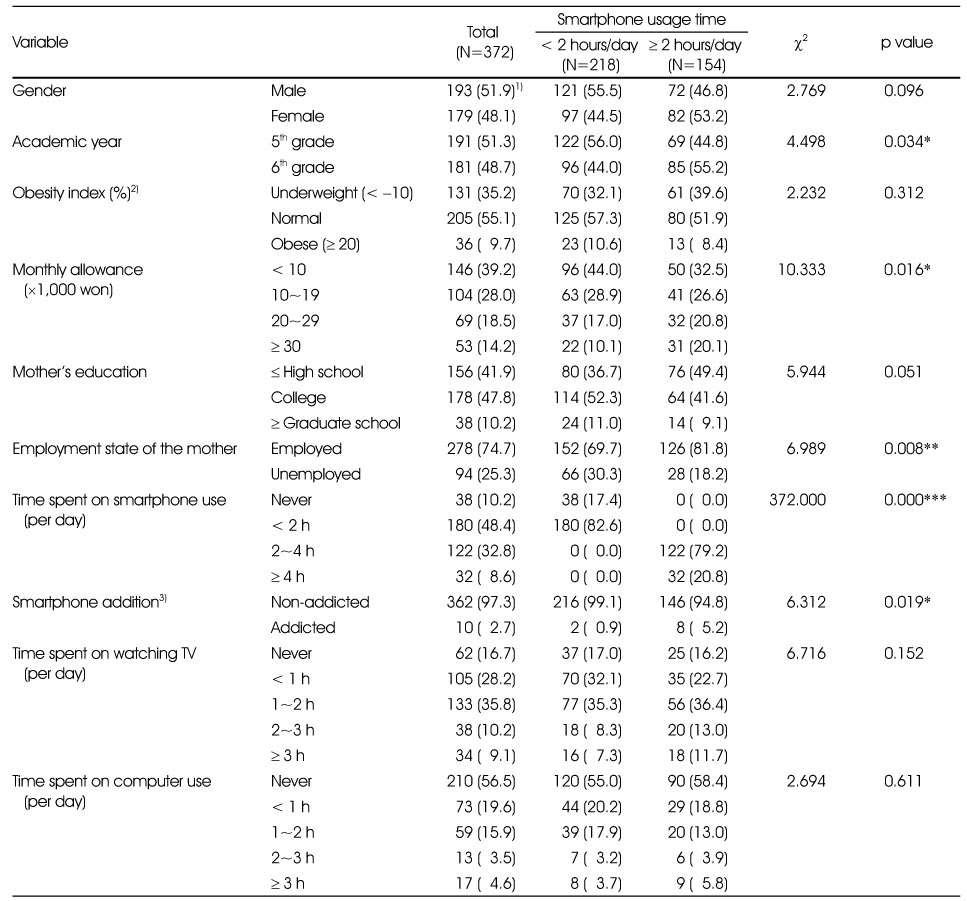
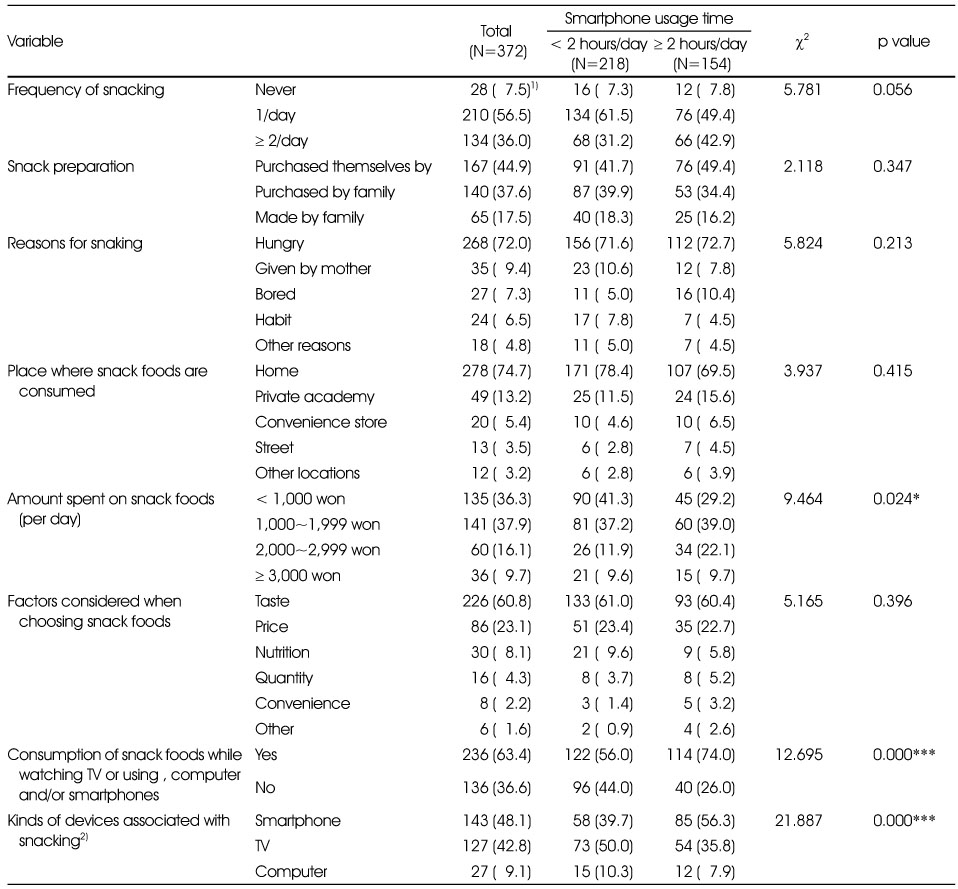
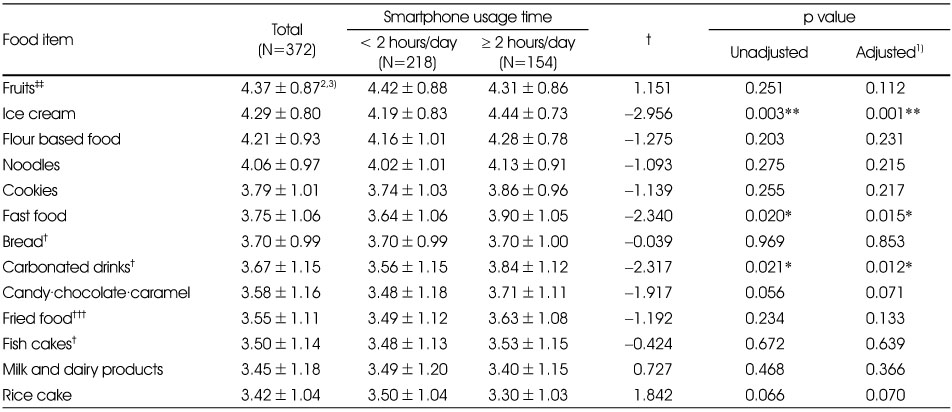
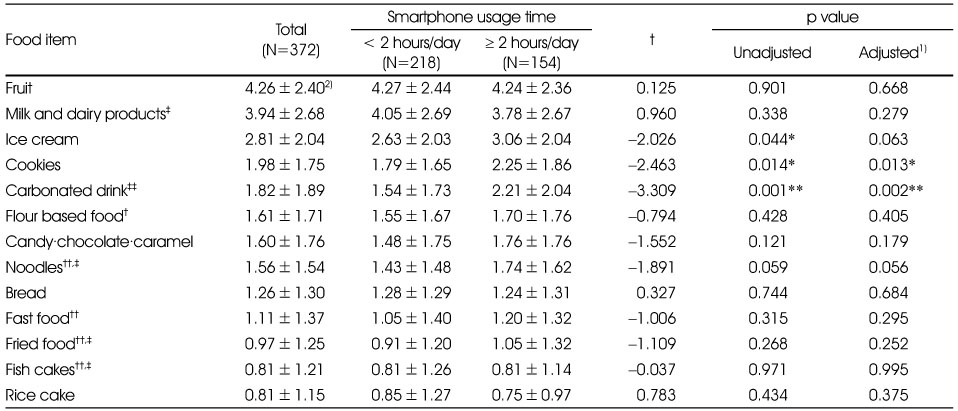
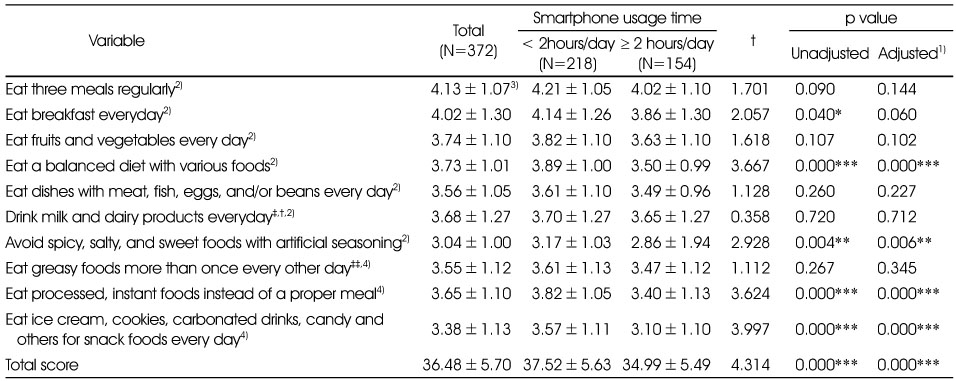
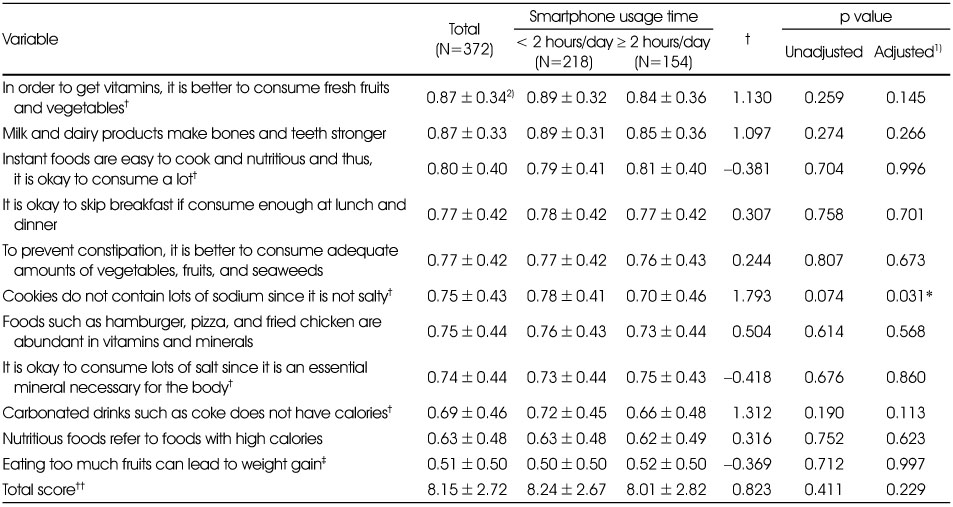
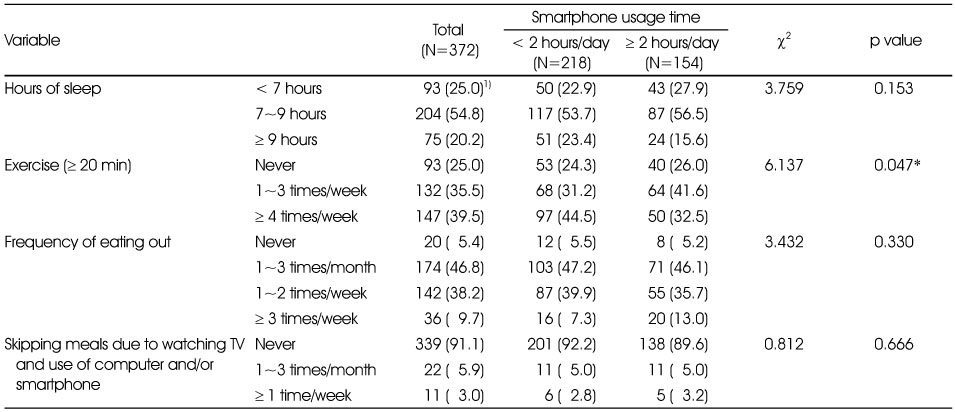
 Cite
Cite


